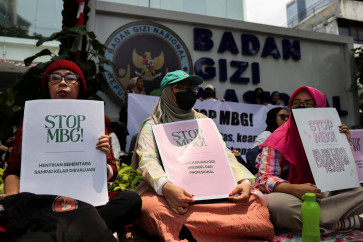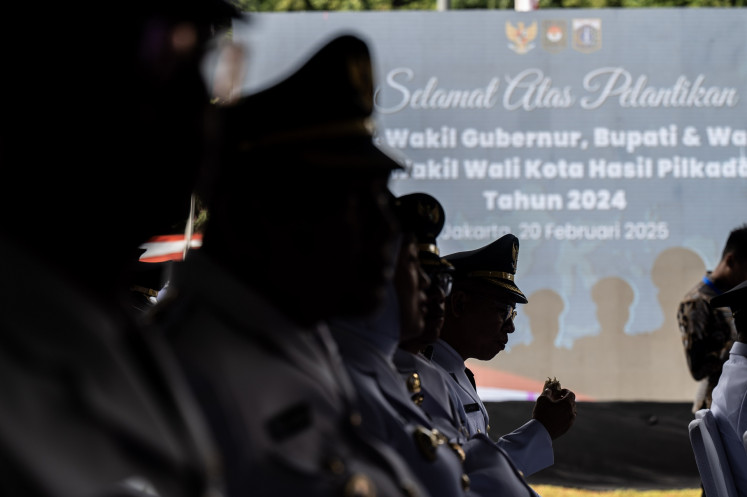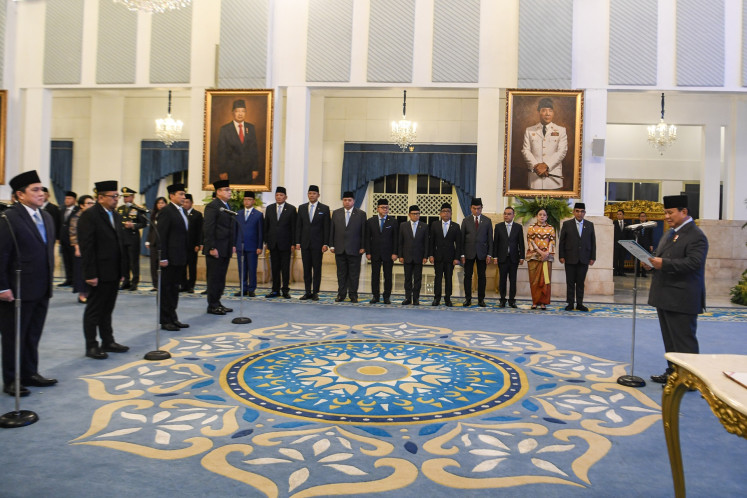Popular Reads
Top Results
Can't find what you're looking for?
View all search resultsPopular Reads
Top Results
Can't find what you're looking for?
View all search resultsUsing the viral power of social media for marketing
Online marketing: In the past two years, local companies, such as motorcycle taxi operator GO-JEK, have increasingly recognized the usefulness of online social media for connecting customers with their brands
Change text size
Gift Premium Articles
to Anyone
O
span class="caption" style="width: 398px;">Online marketing: In the past two years, local companies, such as motorcycle taxi operator GO-JEK, have increasingly recognized the usefulness of online social media for connecting customers with their brands. JP/Ricky YudhistiraFor many marketers, the last two years have been a crusading period as many have harnessed the viral power of social media to generate hype for their products and services.
For up and coming entrepreneurs like Nadiem Makariem, the founder and CEO of GO-JEK, social media has helped catapult fledgling brands into the light. Launched in February this year, GO-JEK offers professional motorcycle taxi services, in addition to instant couriers, for on-the-go Jakarta citizens.
According to Nadiem, efforts to market GO-JEK rested solely on Twitter and Facebook, as they did not have sufficient funds for large scale campaigns. “We did not want to spend unnecessarily,” he told The Jakarta Post.
To get the GO-JEK name abuzz on Twitter, Nadiem reached out to the “Twitterati”, people whose accounts have thousands of followers, to spark early conversations on the brand.
Some of Indonesia’s Twitterati have over one million followers. GO-JEK itself has close to 3,000 Twitter followers and more than 3,500 Facebook likes. It helped too that the product was inherently unique as this gave more reasons for people to tweet about it.
“We got hold of several bloggers and Twitterati by giving them a few free rides just to test the product and fuel the talk,” he said.
Newcomers in the business scene were not the only ones jumping on the social media bandwagon. Wall’s, a subsidiary of consumer product giant PT Unilever, capitalized on the medium to jump start its brand of Magnum ice-cream in 2010.
The trend for large corporations to use Facebook as a marketing touch point was pointed out in
the “Power of Like” report by Comscore, highlighting that all US Ad Age Top 100 Advertisers owned Facebook pages.
According to Meila Putri Handayani, social media became pivotal in supporting the massive advertisements and activation programs that Magnum undertook to reach out to their target market of “pleasure seekers” — digital savvy adults of 25 years and above.
Another study by Comscore in 2011 showed that more that 25 percent of Internet users in Indonesia were between 25 and 34 years old.
“I think every marketer has been focusing on how to use this medium as a marketing tool,” she said.
She added that Twitter and Facebook allowed brands to engage directly with customers while above-the-line marketing focused on building awareness.
Magnum Indonesia has more than 2 million people on their fan page, with slightly above 25,000 Twitter followers.
In the country itself, Magnum has launched a campaign blitz, which includes prime-time television advertisements, celebrity endorsements and the opening of a Magnum Café in a high-end mall in South Jakarta.
A strong market base in Indonesia has also led companies to make spin-off accounts of their regional or international accounts.
A recent survey by Nielsen found that 90 percent and 19 percent of all Indonesian Internet users accessed Facebook and Twitter respectively. Besides the Philippines, no other Southeast Asian country featured both social networking web sites dominating Internet use.
Audrey P. Petriny, spokesperson of low-budget carrier PT AirAsia Indonesia, said that the company started to run its own social network account, in addition to regional accounts, to “push marketing activities through social media localization”.
Indonesia AirAsia (IAA) aims to net 6.2 million passengers in 2012, a 24 percent increase on this year’s figure.
“AirAsia Indonesia’s Facebook and Twitter accounts are designed to suit the preferences and sensibilities of our Indonesian guests and fans,” she said.
AirAsia has more than 275,000 Twitter followers and one million Facebook fans, while its Indonesian counterpart has over 117,000 and 300,000 respectively.
She added that the airline had established the necessary infrastructure to “handle all social media efforts internally” through a social media team operating out of Indonesia, Malaysia and Thailand.
“Most of our social media are online 24/7, allowing us to respond promptly to queries sent by guests and fans based on the company’s terms and conditions,” she told the Post.
However, managing social media internally was more of a low-cost marketing maneuver for Nadiem, who ran GO-JEK accounts alongside two colleagues.
“We answer questions directly addressed to us,” he said.
However, re-tweeting positive reviews from customers is probably the most important activity of all because these re-tweets were key in spreading the word about GO-JEK.
“This is what needs to be re-tweeted because this is what draws in other customers,” he said.
In an October report, Nielsen suggested that 22 percent of Indonesian Internet users posted reviews while 52 percent read people’s comments on social media about brands, products or services.
Messages posted by GO-JEK, he added, had to contain quirky, innovative ideas that appealed enough for followers to tweet or re-tweet.
“The fact that an ojek (motorcycle taxi) exists is enough reason for people to re-tweet because the idea is quirky,” he added.
Other marketers concur that accounts should be more than just for sales promotions.
Audrey said that social media communications “went beyond” passing information on low fare promotions.
“We also use the media in crisis management. For example, when Mount Merapi erupted in 2010, we announced the [local] airport’s closure through social media,”
she noted.
Social media have also grown to be a useful tool in “keeping a pulse” on the needs of customers who could now send direct feedback on the products and services on offer.
As many as 20 percent of Internet consumers in Indonesia interact with brands on social network sites, a recent Nielsen report shows.
“We once considered discontinuing the Kuala Lumpur — Calcutta route. However, guest and fan shouts on our regional social media channels stopped us from doing so,” Audrey pointed out.
Yet, does a high following equal high sales? Marketers say yes.
Nadiem said that as the number of their followers had tripled in the past six months. GO-JEK serves roughly 100 customers per day with its fleet of motorcycles.
“The majority of our customers heard about us through Twitter, which enough to demonstrate its considerable impact,” he said, adding that Twitter, being more viral, proved a more proficient marketing touch.
Meila also pointed out that Magnum Café experienced an increase in visitors throughout a campaign that was propped up by social media.
“As of December 2011, the number of Magnum Café visitors has reached 320,000 and the café, which was originally planned to operate only for three months, would operate until January 2012,” she said.










